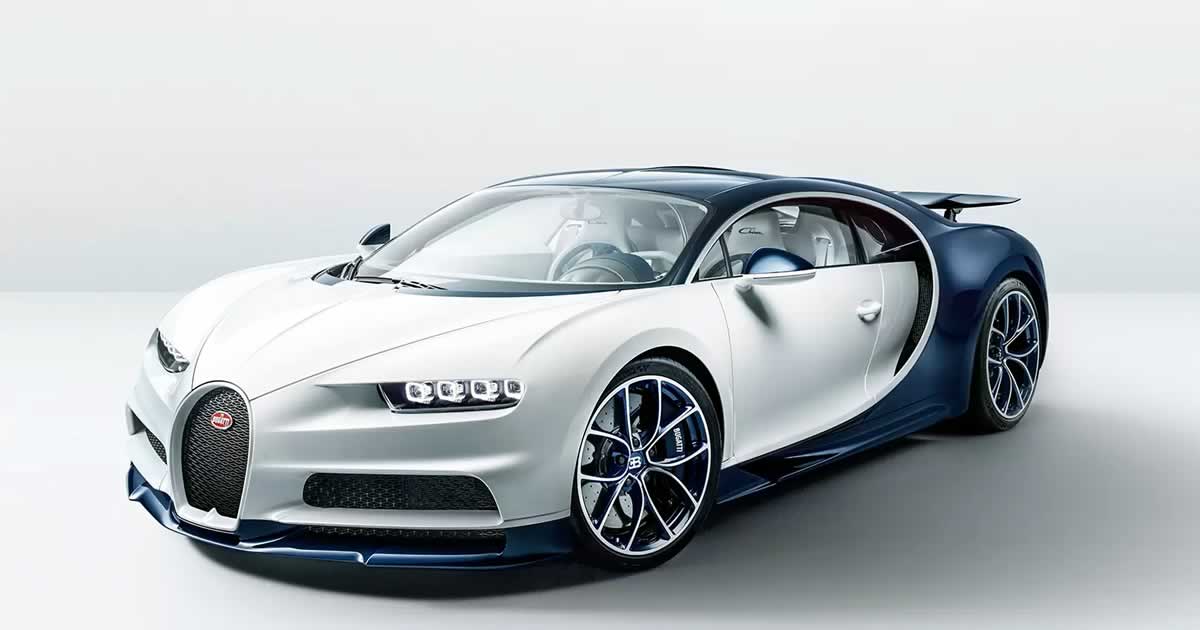Anyone who is a fan of cars certainly wants to have a super sports car in their garage that can reach speeds worthy of Formula 1. You can even have one of these at home; the point is that, in addition to having a limited production, they cost a million dollars amount. But it doesn’t hurt to dream, right? Today, we put together a list of the fastest cars in the world.
Speed is something people want to conquer, and there is no sign of stopping, regardless of whether it’s a necessity or not. Vehicles are moving faster and faster, and the world of supercars is also constantly fluctuating.
Below is a summary of 15 world’s fastest cars. To be included in this list of the fastest cars in the world, the requirements are that they be models from 2018 or newer, be currently in production and have the corresponding approval for driving on public roads.
Fastest Cars In The World:
15. Ferrari LaFerrari (350 km/h)
Ferrari LaFerrari — one of the fastest cars on this list with the least speed — debuted for the first time in 2013 to replace the previous legendary Enzo.
Equipped with a 6.3L V12 engine on LaFerrari for a capacity of 789 horsepower(hp) with a maximum speed of 9250 rpm. This engine comes with an electric motor with a capacity of 160 hp, bringing a total capacity of 949 hp, and a 7-speed dual-clutch gearbox with Ferrari Formula 1 technology.
LaFerrari is capable of accelerating from 0 to 96km/h in 2.4 seconds and runs all the way to 400m in 7.7 seconds. The maximum speed of LaFerrari reaches 349 km/h. There are many other personal tests that take place and show that the model can reach a maximum of more than 370km/h, but that number is unilateral and not recognized.
14. Aston Martin ONE-77 (354 km/h)
First appearing 12 years ago, the Aston Martin ONE-77 is a rather rare model of the brand in the category of fastest cars in the world. The Aston Martin One-77 is one of those supercars that you dream of even being a millionaire because of its exclusivity. It is a two-seater super sports car with an aluminium body. The automaker “embraced” the classic values of cars when it has built the ONE-77 (only 77 cars are produced).
It uses Carbo-ceramic brakes, adaptive suspension, a carbon-fibre monocoque chassis and hand-built aluminium body panels. The engine does not use any turbocharger, and no hybrid electric motor only uses a pure 7.3-litre V12 engine that uses the dry-sump lubrication system. This engine delivers a power of 700 hp and 750 Nm of torque. The maximum speed is 354km/h.
13. Pagani Huayra (370 km/h)
The Pagani Huayra has two bodies and four versions in total, the Huayra, the Huayra BC, the Huayra Roadster convertible and the Huayra R. All versions are built from a central body in carbon fiber and titanium, with chrome-vanadium alloyed steel front and rear subframes to combine maximum rigidity with minimum weight.
The Pagani Huayra is equipped with a Mercedes-AMG V12 engine with a double turbocharger that develops between 750 and 829 CV, coupled to a double-clutch gearbox. The total mass of the Pagani Huayra is an incredible 1,350 kg. The top speed of Huayra is 370km/h, and the ability to accelerate from 0-96km/h in 2.2 seconds.
12. McLaren F1 (386 km/h)
The McLaren F1 is one of the best street sports cars in the history of the automobile industry developed McLaren Cars. The vehicle was developed in partnership between McLaren and BMW Motorsports, with the latter in charge of supplying a V12 engine.
The production of this sports car for the streets, although conceived as a competition vehicle, began in 1994. With different stages of progress, 64 copies were built over a period of almost 4 years. All production took place in Great Britain. The copies are currently valued at over a million dollars.
The design criteria of the McLaren F1 are excellent, placing the driver in a central position with two companions on his sides, although displaced to the rear. The central arrangement of the engine and gearbox allows for optimal weight distribution. This is remarkably favourable when manoeuvring the vehicle at high speeds or corners with high lateral acceleration. The engine was built by BMW Motorsports. The result was a majestic 6,064 cm3 DOHC V12 with an output of 627 hp at 7,400 rpm and a maximum torque of 649 Nm at 4,000 rpm.
11. Koenigsegg CC Series (402.3 km/h)
In 1996, Koenigsegg announced “CC” and became one of the supercar makers. The “CCX” debuted in 2006; then the “CCXR” model came in 2008. Soon the speed limit of Koenigsegg CCX seemed to be a little limited under conventional power, and the endless increase in displacement would also pollute the environment, so Koenigsegg built CCXR on the basis of CCX with special fuel.
It is powered by a 4.7-litre supercharged V8 engine with four valves per cylinder. Although the fuel used by CCXR biomass fuel (a brand new fuel refined from plants and mixed with gasoline/diesel), its power output is still quite amazing, up to 1018 horsepower (7200 rpm) and a maximum torque of 1060Nm (6100 rpm).
With a vehicle weight of only 1180kg, the CCXR can accelerate from 0 to 100km/h in 2.9 seconds, and the top speed can exceed 400km/h. The Koenigsegg CCXR was once the fastest production car in the world. Koenigsegg CCXR has a fierce and aggressive design, and most of the sheet metal of the entire body is made of carbon fibre. Whether it is assembling or manufacturing, it involves a lot of pure manual labour, plus expensive raw materials, which is the reason for its amazing price.
10. McLaren Speedtail (402.3 km/h)
The Speedtail is one of the fastest car ever built by McLaren throughout its history. This is a project developed by the McLaren Special Operations division to create a successor to the McLaren F1, a spiritual relay that recovers the idea of that supercar from the ’90s while creating a car capable of reconciling high performance and luxury.
In this way, we can consider the McLaren Speedtail as a hypercar or Hyper-GT, given the special emphasis it places both on its ability to be one of the fastest cars in the world and on being one of the most luxurious at the same time .
Well planned and innovative construction has been done with the help of carbon fibre and aluminium, achieving an empty weight of 1,430 kilograms. A hybrid drive will be the heart of the McLaren Speedtail, capable of developing 1,050 hp combined maximum power using a system based on a 4.0 V8 Twin-Turbo. The top speed is 403 km/h, a speed that is achieved by using a “Velocity” mode that affects aerodynamics and suspension to reduce downforce. The McLaren Speedtail is capable of doing 0-300-0 km/h in 12.8 seconds.
9. Bugatti Veyron (407.1 km/h)
Bugatti EB110 was the last Bugatti manufactured before the brand was acquired by the Volkswagen Group. Then came the Bugatti Veyron, which was the supercar that signed the return of Bugatti as a manufacturer, already belonging to the Volkswagen Group and becoming the halo car of the entire automobile group by using the most advanced solutions of the moment.
The Veyron was a project that took many years to be brought to production, a model that was a revolution in the automobile industry, taking performance far beyond what brands such as Ferrari, Lamborghini or Porsche had proposed at that time. The Bugatti Veyron, with its 1,001 CV and 408 Km/h, marked a milestone in the history of the automobile.
Its heart is an 8.0 W16 Quad-Turbo capable of developing 1,001 hp of maximum power and 1,250 Nm of torque in the first versions and 1,200 hp of maximum power and 1,500 Nm of torque in the SuperSport versions. The Bugatti Veyron’s performance speaks for itself, with acceleration from 0 to 100 km/h in 2.5 seconds.
8. SSC Ultimate Aero TT (412 km/h)
The SSC Ultimate Aero TT, one of the most extreme cars in the world. The second-generation SSC ultimate aero adopts a new aerodynamic design and has a top speed of 412km/h. The car’s almost absurd, unimaginable performance comes from its 7 litre 1,183-horsepower twin-turbo V8s.
The result of cramming this crazy engine into a sedan is a car that weighs about as much as a Dodge Neon. The SSC Ultimate Aero TT pushes speed and power to new limits with its V8 twin-turbo engine 1180 hp/6950 rpm maximum power and 1340 Nm/6150 rpm maximum torque, can do 0~100km/h in 2.8 seconds.
7. Bugatti Chiron (420 km/h)
The appearance of the next miracle of the company “Bugatti” — the successor to the legendary model “Veyron”. In all directions, Bugatti Chiron exceeds its predecessor and has a length of 4544 mm, of which 2711 mm penetrates under the distance between the pairs of wheels, 1212 mm in height and 2038 mm in width.
Bugatti Chiron weighs 1995 kg. The 8.0-litre W16 four-turbo engine (a pair of superchargers working immediately and the second is activated after 3800 rev/min) has a maximum power of 1,500 horsepower and a maximum torque of 1,600 Nm. Together, it can accelerate to 100 kilometres in less than 2.5 seconds.
However, its speed limit is not yet known, as there will be software limiting the speed to 420km/h. When the constant top speed is maintained, a 100-liter two-dimensional tank will be empty in 9 minutes.
6. Bugatti Veyron SuperSport (430 km/h)
The Bugatti Veyron SuperSport is one of the fastest production vehicles in the world. The average top speed of the car is 431km/h, and it only takes 2.5 seconds to accelerate from 100 km/h. It was launched on June 26, 2010.
This car created a Guinness World Record for the title of the fastest production car. The W16 engine of the Veyron SuperSport uses a larger turbo and intercooler, and the horsepower output rises to 1,200 hp, which is 199 hp higher than the normal version of the Veyron. Torque has also been raised to an even more astonishing 1500NM.
The whole car body is made of a new carbon fibre weave method, which further improves the strength of the car body and reduces the weight of the car at the same time. The exterior of the body is covered in carbon fibre. Using the new NACA engine air intake preset, the engine is surrounded by a large area, which improves the empty engine performance.
5. Hennessey Venom GT (435.31 km/h)
Hennessey Venom GT is a super sports car launched in 2011 by Hennessey, a famous sportscar tuning company. Hennessy claims that the car can reach a top speed of 440km/h and is limited to 10 units worldwide. Venom GT is a model derived from the chassis of the famous British sports car brand Lotus Exige.
It can achieve a top speed of 435.31 km/h, and it can easily reach terrifying speeds in a few seconds while the average car is just warming up. It is powered by the LS9 6.2-litre V8 supercharged engine from the Chevrolet Corvette ZR1, with a maximum power of 1200 horsepower. The car accelerates from 0 to 60mph (96km/h) in 2.4 seconds, to 100mph (160km/h) in 5.3 seconds, to 150mph (241km/h) in 8.9 seconds, and to 200mph (321km/h) in 14.3 seconds.
The whole vehicle of the Hennessy Venom GT is made of carbon fibre and aluminium alloy, and the curb weight is only 1,244kg; the transmission system is a six-speed sequential type. Gearbox, mid-engine rear-wheel drive, with specially tuned traction control. The Hennessy Venom GT won the title of ‘the world’s fastest production car’ that once belonged to the Bugatti Veyron with its amazing speed.
4. Koenigsegg Agera R (439 km/h)
Koenigsegg could not get enough with the “normal” model of the Agera, so they created the Agera R, whose chassis weighs just 70kg and has a net weight of 1,330 kg, the lightest in the supercar segment.
The 5.0-litre V8 engine it uses is twin-turbocharged, with a maximum horsepower of 1115 horsepower and a maximum torque of 1200 Nm when using E85 fuel, 1100 Nm. The entire engine, including flywheel, clutch, dry oil casing, exhaust system and turbo, weighs only 197 kg.
The Koenigsegg Agera R is quite fuel-efficient for a super sports car, with fuel consumption of only 14.7 litres per 100 kilometres. Matching a 7-speed transmission and for the first time using a dual-clutch system, the result is the fastest shifting speed in history. Another special equipment is the new E-Diff, which Koenigsegg says allows the Agera to drive it safer and improves performance. All the Agera models have a speed limit of 375 km/h, but if conditions allow Koenigsegg to break through the limit, then it can run up to a top speed of 439km/h.
3. Koenigsegg Agera RS (457.94 km/h)
The Agera RS was nothing like the world had seen before it was released. Amazingly fast, incredible to look at and a demonstration of technical exercise that no one could have dreamed of in the automotive world up to that point.
Equipped with a 5.0-litre twin-turbocharged V8 engine, the Agera RS produces 1,176 horsepower and 940 pound-feet of torque in its standard form. The 1 MW improves on these numbers to 1,360 horsepower and even 1,000 pound-feet of torque.
The Agera RS reaches 60 miles per hour in just 2.9 seconds and accelerates to 124 miles per hour in less than 7 seconds. The engine has been designed to deliver its maximum output even on regular gasoline, and E85 ethanol can be used in certain markets. RS specification levels are highly customer dependent, only 25 units were produced at the time.
Its interior is very unique. Most of the switches and dials may look weirdly awesome to anyone unfamiliar with the brand. This is a good thing in the rare sector that the Agera RS resides in, and even before you enter the vehicle, the dihedral synchrohelix doors will rise up in the most unusual way to greet you.
2. Bugatti Chiron Super Sport 300+ (482.80 km/h)
Bugatti shocked us after revealing a prototype of its Bugatti Chiron, which had reached the speed of 482 km/h on a test circuit. Then after some time, the brand presented the Bugatti Chiron Super Sport 300+ that will have a price of 3.9 million dollars per car and of which only 30 will be manufactured for the whole world.
The Chiron Super Sport 300+ gets its name from the challenge that they have managed to overcome the 300 miles per hour (482 km/h) barrier. Unlike the normal Chiron, the Super Sport 300+ has an elongated body at the rear with new details to channel air and cool the engine. In addition, the exhaust system is different — it is highlighted with a fibreglass body, exposed carbon with orange details. Under the hood, it uses the same engine that carries the prototype that achieved the aforementioned speed, an 8.0-litre four-turbo W16 capable of delivering 1,600 hp, 100 hp more than a normal Chiron.
1. SSC Tuatara (508.55 km/h)
SSC Tuatara — more than 10 years have been needed to create this work of engineering that will make motor lovers jump with emotion. The first unit debuted at the Philadelphia Auto Show, replaces the SSC Ultimate Aero TT, the fastest vehicle in the world — from 2007 to 2010 — which entered the Guinness Book of Records by removing the position to the Bugatti Veyron.
When after three years of holding the first place, the Veyron 16.4 broke it, they needed to start with a new project that would give them back the glory.
With a 5.9 V8 bi-turbo engine, developed together with Nelson Racing Engines, it reaches 1,775 hp and 8,800 rpm, characteristics that will allow it to exceed 483 km/h. The vehicle in question, of which only 100 units is launched on the market, will use E85 fuel based on a huge forced intake system. It will also have a seven-speed sequential transmission — with the signature of the specialist CIMA — integrated with a state-of-the-art Automatic AMT system, which allows gear changes in less than 100 milliseconds. The amazing body of Tuatara is made of carbon fibre to make it lighter and stronger. Jason Castriota designed this powerful machine. He is a specialist who also worked for Maserati and Ferrari.
So which one would you choose to have in the garage?






Leave a Comment